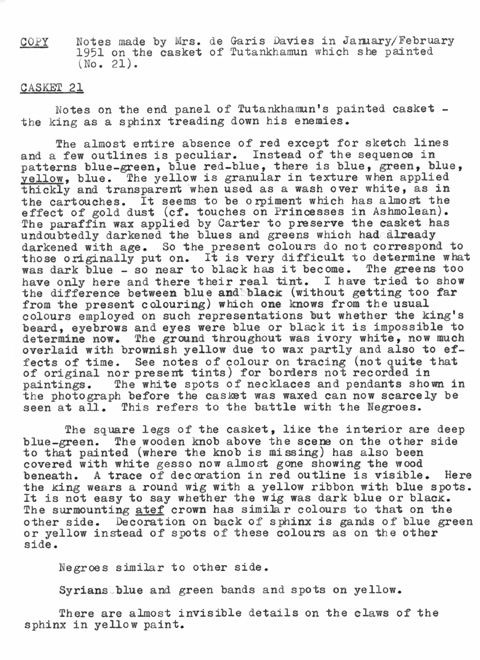Handlist description: Painted wooden box
Card/Transcription No.: 021-01
COPY Notes made by Mrs. de Garis Davies in January/February 1951 on the casket of Tutankhamun which she painted (No. 21).
CASKET 21
Notes on the end panel of Tutankhamun's painted casket - the king as a sphinx treading down his enemies.
The almost entire absence of red except for sketch lines and a few outlines is peculiar. Instead of the sequence in patterns blue-green, blue red-blue, there is blue, green, blue, yellow, blue. The yellow is granular in texture when applied thickly and transparent when used as a wash over white, as in the cartouches. It seems to be orpiment which has almost the effect of gold dust (cf. touches on Princesses in Ashmolean). The paraffin wax applied by Carter to preserve the casket has undoubtedly darkened the blues and greens which had already darkened with age. So the present colours do not correspond to those originally put on. It is very difficult to determine what was dark blue - so near to black has it become. The greens too have only here and there their real tint. I have tried to show the difference between blue and black (without getting too far from the present colouring) which one knows from the usual colours employed on such representations but whether the king's beard, eyebrows and eyes were blue or black it is impossible to determine now. The ground throughout was ivory white, now much overlaid with brownish yellow due to wax partly and also to effects of time. See notes of colour on tracing (not quite that of original nor present tints) for borders not recorded in paintings. The white spots of necklaces and pendants shown in the photograph before the casket was waxed can now scarcely be seen at all. This refers to the battle with the Negroes.
The square legs of the casket, like the interior are deep blue-green. The wooden knob above the scene on the other side to that painted (where the knob is missing) has also been covered with white gesso now almost gone showing the wood beneath. A trace of decoration in red outline is visible. Here the king wears a round wig with a yellow ribbon with blue spots. It is not easy to say whether the wig was dark blue or black. The surmounting atef crown has similar colours to that on the other side. Decoration on back of sphinx is gands of blue green or yellow instead of spots of these colours as on the other side.
Negroes similar to other side.
Syrians blue and green bands and spots on yellow.
There are almost invisible details on the claws of the sphinx in yellow paint.
